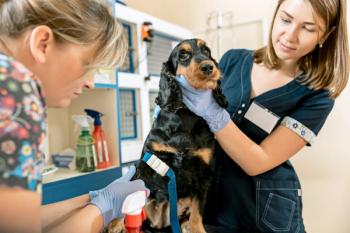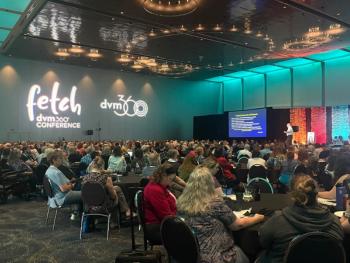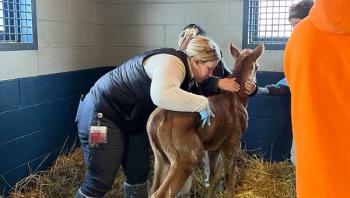
Governane, disaster summit top AVMA action
Schaumburg, Ill. — Political jockeying between the American Veterinary Medical Association's (AVMA) ruling parties eases as the organization moves closer to a revised governing accord.
SCHAUMBURG, ILL. — Political jockeying between the American Veterinary Medical Association's (AVMA) ruling parties eases as the organization moves closer to a revised governing accord.
Key players in the House of Delegates (HOD) met at length with Executive Board members during their November meeting to discuss axing the association's constitution and beefing up its bylaws. While critics contend the House's move to modify the bylaws masks an attempt to strip power from the Executive Board, leaders on both sides of the project publicly deny such claims. Chicago attorney Jed Mandel, called in to consult on the revision, notes modern corporations rarely have a separate constitution and bylaws. And AVMA needs to better articulate its division of authority between the two governing groups, he says.
"The way I think it will come out is that the day-to-day management will lie with the Executive Board and the establishment of policy will lie within the House," he says. "Most organizations don't have this separation of legislative and judicial authority. They don't have a House. All delegation of authority resides with the board."
Overhaul
Mandel doesn't advocate dismembering the House, but historically, AVMA's policy-making lines of have blurred. Executive Board members meeting six times a year often adopt positions not seen by the House, which represents the association's 72,000 members but only gathers biannually.
That's an overlap of duties, but the practice will be maintained, says Dr. Charles Stoltenow, chairman of the House Advisory Committee. The North Dakota extension veterinarian is largely responsible for turning what originated as a charge to clean up redundancies in AVMA procedural language into an overhaul of the checks and balances system that's governed the association for 50 years.
While the current rewrite is under wraps, insiders note a push to developing procedural mechanisms to handle late resolutions and amending them on the House floor. An attempt also exists to name the HAC chair an ex-officio member of the Executive Board. The move does not come with voting power, but it formalizes the House's voice at Executive Board meetings.
"There really aren't controversial issues here," Stoltenow says. "There's an educational curve and an initial lack of understanding, but that just means people aren't comfortable with what's being presented to them."
Comfort increases
To facilitate communication, two members each from the Executive Board and House have been charged with collecting and correlating stakeholder comments on the proposal and performing final edits. The board's larger role in the rewrite's development process has eased critic contentions, member Dr. Bud Hertzog says.
"We're all on the same page and things are moving well," he says. We've gone all out to get input. It's a good-faith effort to bring everything together."
Stoltenow intends to introduce the bylaws modifications to the House during AVMA's annual meeting in July. A final vote is not predicted until later this year.
Disaster focus
Also planned for 2006 is the AVMA-led National Animal Disaster Summit, designed to unite humane organizations and government agencies to evaluate recent natural disaster experiences, including hurricanes Katrina and Rita. While Executive Board members opposed the summit's adoption following its initial recommendation last year, association leaders now seek to develop a more efficient model to deal with large-scale disasters in the future.
At presstime, Hertzog appointed members to a steering committee to plan the event. Early staging will begin in 2006.
"We want this to be a top-notch event and get the right people to the table," Hertzog says. "We have some indication there will be other funding available."
Board members also approved expanding Veterinary Medical Assistance Teams (VMAT) roles to incorporate state and local issues. VMAT members could instruct and accredit state veterinary assistance teams for disaster preparedness, AVMA leaders say.
Expanding profession's scope
In response to last year's National Academies reports outlining needs for the profession's expansion into public health, AVMA introduces Research for Healthy Animals 2010. Its mission is to enhance the size and diversity of the national veterinary workforce and bolster professional services across all demographics.
The charge comes from AVMA's Council on Research. Goals include developing and cultivating sustained funding resources dedicated to advancing health and welfare of companion and food animals as well as wildlife.
AVMA seeks to prepare and train more veterinarians for careers in biomedical research, public health, comparative medicine, food systems and ecosystem health.
The position recognizes infrastructure and resource needs for laboratories, veterinary schools and related institutions to provide environments conducive for learning, research and clinical care.
The association also wants to encourage veterinarians engaged in biomedical and bioveterinary research, especially in comparative medicine.
Veterinary medicine has the national responsibility to care for and protect animal and public health as well as food systems and the environment, the statement says. "Its stewardship in these areas is challenged by new and re-emerging diseases that arise from characteristics particular to today's society. Traditional approaches will require innovative strategies and measures to successfully and effectively address these diverse risks into the future."
Newsletter
From exam room tips to practice management insights, get trusted veterinary news delivered straight to your inbox—subscribe to dvm360.




